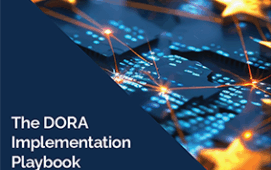Blockchain, or distributed ledger, technology is expected to track a similar adoption curve as the internet, with a period of inspiration and experimentation being followed by a phase of ‘crossing the chasm’, and a final phase of growth and mass adoption leading to full maturity of the technology by 2035.
A recent report by Citisoft considers the impact of blockchain on the buy side – to date, most research and reporting has covered the sell side – sets out a potential adoption curve for the technology, and suggests how data management and reporting will change as blockchain is rolled out.
The report, Back to the Future: A Buy-Sider’s Guide to Blockchain authored by Citisoft directors Ben Keeler and Alissa Doherty, also likens the disruption and revolution caused by the advent and evolution of the internet to the impact blockchain technology could have on the asset management lifecycle. It states: “What the internet has done for the exchange of information, blockchain promises to do for the exchange of value.”
The Citisoft blockchain adoption curve is split into three phases. The initial inspiration and experimentation phase is expected to run from 2009 to 2019 and includes governments and regulators encouraging exploration of the technology, consortia investing in applications and best practice, and early applications focussing on the exchange of non-liquid security transactions and smart contract agreements.
While this phase is coming to an end, and will have little or no impact on data management and reporting, Citisoft notes that it raises questions around standards, security, scale, exception processing and buy-side aversion to the adoption of early stage technology.
Phase two adoption, ‘crossing the chasm’, is expected to span six years from 2019 to 2025. It is characterised by most complex OTC transactions using blockchain technology and making post-trade processing and credit intermediaries unnecessary, more mainstream transactions using blockchain and diminishing the need for reconciliation and settlement processes, and market and reference data providers being threatened by readily available data on distributed ledgers.
Looking at the impact of blockchain on asset managers during phase two of adoption, the report suggests that the use of blockchain in the front office for mainstream security transactions will reduce the need for custody, settlement, trade processing and reconciliation in the middle and back office. In terms of data management, asset managers my become less reliant on data services if market and reference data is available from distributed ledgers. They may also tap into blockchain protocols to keep records on an internal private chain to support regulatory requirements and reporting.
The third phase from 2025 to 2035 covers growth and mass adoption. It includes blockchain being used across asset classes, accelerated migration from legacy technology and processes, the rise of new service providers that will change the capital markets ecosystem, and by 2035, technology maturity.
Through this phase, and with mutual ownership of shared ledgers, Citisoft expects investment managers’ reliance on custodian services to diminish, multiple accounting and investment books of record to be replaced by a common, known set of settled transactions, and the burden of regulatory reporting to become a thing of the past.
The impact of this phase of adoption on asset managers will see the front office conducting all transactions via blockchain and benefitting from lower costs, better price discovery and reduced counterparty risk, data being available via internally and externally permissioned blockchains, and regulatory reporting woes becoming obsolete as regulators access transaction records directly.
Subscribe to our newsletter




